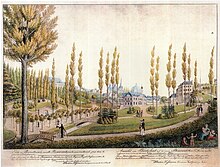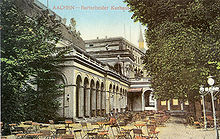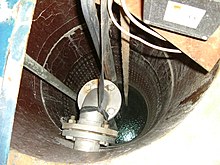Burtscheid spa gardens

The Kurpark Burtscheid is a park in the Burtscheid district of Aachen that was laid out at the end of the 18th century . The Burtscheider Kurpark is the oldest park in Aachen and its size and use have been changed several times over the years. Up until the middle of the 20th century, more than 15 artesian thermal springs sprang up within the spa park . There are several listed buildings on the park area, such as the relocated Nuellens Pavilion , the Fürstenbad and the former Neubad .
Location and thermal springs
The park is located in the Burtscheider valley that today the course of Burtscheider thrust traces. Linked to this deep geological fault, numerous artesian outflowing thermal springs with a temperature of 55–76 ° emerge . Today, the spring water is by pumping Rosenquelle below as far as the source water level of the smaller sources that these dried up largely or are overbuilt. In the deepest part of the valley the warm brook, the Wurm, flows today . The worm channel traces the natural course of the stream and absorbs the waste water from the thermal springs. In order to ensure the water supply of the settlement downstream with fresh water, part of the creek was artificially relocated above the thermal spring outlets as early as Roman times . This Cold Bach , which is also canalized today, runs in the area of Dammstraße and today's spa park immediately northwest of the Warm Bach. Until the 19th century, only a narrow earth dam separated the then openly flowing waters. The two courses of water and the thermal springs became the decisive design element of the spa park.
history
19th century to mid 20th century
Up until the end of the 18th century, the area of today's spa park was a meadow landscape outside of Burtscheid's residential development in the so-called Untere Feld . Since the Middle Ages at the latest, numerous diffuse spring water outlets have been known in the area of today's spa gardens, the warm waters of which collected in small spring pools and temporary basins. According to Blondel, these spring pools were shared by the poor and cattle as public bathing and watering places. A very abundant thermal spring at the foot of the Michaelsberg was discovered in 1609. In order to be able to grasp the source, the approx. 3 m thick floodplain clay was removed and the source was captured in the area of the spring limestone. This spring formed the center of the spa promenade laid out at the end of the 18th century. During the French period in 1807, plans were drawn up to expand the spa promenade and to create a park in the English style .
The streams, which at that time were mostly open, were included in the design and bridged by narrow bridges. As early as 1820 one began to vault the Warm Bach in sections and to regulate the discharge of colored sewage from the textile factories. In order to be able to enlarge the promenade in the area of the drinking source, the municipality of Burtscheid bought a 98 square rod (approx. 1390 m²) meadow parcel on the Kalten Bach for 300 Thaler from the Michels & Homberg brothers on March 5, 1822 . In the years 1821 to 1823, minor reconstruction work was carried out on the source catchment and the green areas were redesigned by the Aachen city gardener Martin Hoffmann.
In the middle of the 19th century, efforts to revive bathing life through attractive spa facilities increased. In 1853, Friedrich Joseph Ark submitted a plan to the municipal council for the construction of a new drinking fountain, which was to be integrated into a foyer with arcade arches . The foundation stone for the foyer was laid on January 10th, 1854. During the construction work, about 6 m from the original source, a new, productive source quarry was developed and scientifically examined. In 1855 the new spa fountain with the foyer was completed and officially opened. As early as July of the same year, the Burtscheid municipal council entered into negotiations to purchase another plot of land to expand the spa facilities. On July 17, 1856, the Aachen construction company purchased an area of 1270 square rods (approx. 18,000 m²) between the Burtscheider Viaduct , the Kurbrunnen and Bergische Gasse for 5272 Reichsthalers. On September 4, 1856, the city gardener Jancke from Aachen received the order to redesign the spa gardens. In the course of the renovation work in 1857, a large piece of the cold and warm brook in the area of the spa park was vaulted (construction costs: 171 Reichsthaler). In June 1858 the redesign of the park was completed. The new drinking fountain should honor of the Crown Princess Victoria at the decision of the City Council of 8 August 1858 in Victoria Fountain be renamed. Confirmation by the royal family took place on February 22, 1859.
In the following years the spa park developed into the cultural center of Burtscheid. Spa music was performed several times a day in a small music pavilion; Since 1864 these concerts could only be attended for an admission fee in favor of the association for the revitalization of the bathing season .
In 1865 another section of the Kalten Bach was arched over. When Parkstrasse was laid out as a connection between Kurbrunnenstrasse and Bergische Gasse in 1876, the park was divided. In the following years, the site between the viaduct and Parkstrasse was gradually built on. Due to the high extraction of thermal water in the Rosenbad and Carlsbad hotels located directly at the spa gardens, the filling of the Victoria spring decreased in the 1870s, so that from 1876 thermal water from the wool brew spring at Burtscheider Markt had to be added to the drinking fountain.
In 1885 the city council granted the concession to set up a drinking hall at the entrance to the spa park. In 1887 it was decided to build a spa house that would integrate the Ark'sche Wandelhalle. The Kurhaus with a 300 m² ballroom, restaurants, a beer hall and reading and billiard rooms was inaugurated on May 19, 1889 after a two-year construction period according to plans by Eduard Linse . In the course of the construction of the Kurhaus, the green area was also redesigned by P. Eichling. The center of the spa park, which was closed in 1884, was a water fountain and a music pavilion.
Despite the enormous efforts, Burtscheid was only able to compete with spa life in Aachen to a limited extent. One reason was the close proximity between spa facilities and textile factories in the narrow Burtscheider valley. For example, the von Halfern'sche cloth factory was directly adjacent to the spa garden .
During the First World War , the great ballroom was set up as a hospital . After the First World War, the Kurhaus was confiscated by the Belgian occupation troops, who were stationed in Aachen until November 30, 1929 due to the provisions of the Versailles Treaty . As early as April 8, 1920, the Aachen product and commodity exchange was opened in the halls of the Burtscheider Kurhaus , which was intended to stimulate the economy in the occupied territories. The spa business came to an almost complete standstill in the 1920s - the park was only occasionally used for cultural events.
During the Second World War , the Burtscheid spa center was almost completely destroyed, particularly by the air raid on April 11, 1944.
Post-war development

All of the burned-out spa hotels on Dammstrasse - with the exception of Neubad - were not rebuilt after the war. The Kurhaus with the foyer was also badly damaged. In the 1950s, the Kurhaus was first demolished except for the entrance hall and parts of the Ark'schen Wandelhalle. On June 1, 1952, the provisionally restored spa park was opened to the public again. The first spa concert after the war took place on July 5, 1955. Two years later a new music pavilion was inaugurated, which was torn down again in 1964. On August 17, 1955, the new Victoria fountain with thermal water was also reopened. In 1961, the Rosenquelle was revised, which is now located in a technical operating room below the lawn and keeps the spring water level in the Dammstrasse area at a level that is harmless to the surrounding building fabric.
A fundamental new concept for the design of the entire Burtscheider spa facilities was decided on October 26, 1961. The redesign required the demolition of the foyer, the remains of the Kurhaus and the music pavilion in order to create the building site for the spa park terraces. Simultaneously with the construction of the spa park terraces , the Burtscheider spa park was again fundamentally redesigned and the properties of the former bathing hotels Rosenbad , Karlsbad, Michaelsbad and Krebsbad were included in the facility planning. In addition, the park in the northwest was able to benefit from the demolition of the former cloth factory in 1960.
In May 1962, the newly designed green spaces on Dammstrasse were opened to the public. This included the new staircases and walls, into which the historical bluestone coats of arms of former abbesses were integrated, such as the coat of arms of the Adolphus Georgius Franciscus Wilh family. De Colyn († May 21, 1753) and his wife Maria Sophia Alexandrina Wilhelmina Ab Herssel († June 14, 1752). A bronze sculpture The Seated Woman by Heide Dobberkau, financed with the help of the Aachener Bank Foundation, was erected in July 1962 near the former Michaelsquelle .
As the only evidence of the earlier spa and bathing system in Dammstrasse, the former Neubad, which also served as the Burtscheider town hall, was preserved on the initiative of the Aachen city curator Hans Königs and restored by the architect Leo Hugot in July 1963 as a city spa - and the advertising office will be reopened.
In the center of the Burtscheid spa park, the spa park terraces were inaugurated on June 8, 1965. The construction costs for the project designed by the building department of the city of Aachen amounted to 750,000 DM . The modern hall building houses rooms for gastronomy and cultural events. Before the rear hall was added in 1985, a drinking and foyer was also integrated here. In front of the building is the Burtscheider spa fountain, which is in operation all year round because it is fed with thermal water from the rose spring.
The spa facilities were finally supplemented in 1969 on the northeastern edge by the construction of a children's playground. There are some old, protected trees in the spa park today, including a yew and a ginkgo from 1823.
Translocations
In order to improve the value of the Burtscheider spa park, the Nuellens garden house, built by Johann Joseph Couven in 1740 , was first moved to the north-east corner of the spa park in March 1961 . The building was originally built for the cloth maker Johann Heupgen in the garden of the property at Friedrich-Wilhelm-Platz 6. From 1840 to 1927 it was used as the garden pavilion for the Hotel Nuellens . After the hotel was closed in 1927, it could be moved to the garden of the Fey house at Seilgraben 34. After its destruction on July 14, 1943, the garden pavilion was first preserved and then moved to the Burtscheider Kurpark.
In the spa terraces integrated, is the only surviving ceremonial bathing cell from the 19th century. The Fürstenbad formed the centerpiece of the late classicist bath hotel Kaiserbad, built by Friedrich Joseph Ark am Büchel from 1862 to 1865 . In 1963 the two mosaic domes were removed from the destroyed Kaiserbad on the initiative of Hans Königs and then later integrated into the new building of the spa park terraces . From Fürstenbad the domes with are now only mosaics original, the marble panels and floor coverings were replaced, missing railings, fixtures and woodwork. In 2003 the Fürstenbad was included in the list of monuments of the city of Aachen.
Current and future plans
At the moment, considerations are being made as to whether the future design of the spa park can include the disclosure of a short stretch of water. In 2013 - made possible by a donation - a new spring house was built for the Rosenquelle. Here you can experience the thermal water and get information about the Burtscheid thermal springs at a media station.
various
To ensure public safety in the spa gardens, a promenade guard was created on July 15, 1857. In addition to the wages of 144 Reichsthalers, he was also entitled to uniform remuneration. The Burtscheider Chronicle also reports tragic events in the spa gardens. On April 18, 1874, the spa guest from Carlsbad Carl Wolframm shot himself in the spa garden.
literature
- Wilhelm Weßberge: The most important tree species in our urban gardens. La Ruelle , Aachen 1908.
- Kurt Jünger: Memories of the Burtscheider spa garden in 12 images. Arend and Ortmann, Aachen, 1978, 12 pp.
- Angelika Pauels: Under eagles and swans: The chronicle of the mayor's office Burtscheid for the years 1814–1886, Einhard, Aachen, 1997, 285 pp.
- Adam C. Oellers : The bathing system in Burtscheid. In: Aachen and Burtscheid over the centuries 997–1997 - An exhibition in the Sparkasse Aachen - Headquarters Friedrich Wilhelm Platz, exhibition catalog, Aachen, 1997, pp. 18–25.
- City of Aachen: Remarkable trees in the city of Aachen. Contemporary witnesses of the city's history. Published by City of Aachen. Aachen Foundation Kathy Beys. Klenkes, Aachen, 2002.
- Juliano de Assis Mendonça: History of the stock corporation for spa and bathing operations in the city of Aachen 1914-1933 , Aachen studies on economic and social history, Volume 9, Aachen 2012, ISBN 978-3-8440-1520-1 , 81 pp.
Individual evidence
- ^ Béatrice Oesterreich & Christoph Senz: Introduction to the geology, hydrogeology and bath history of the Aachen and Burtscheider thermal springs . In: 106th annual meeting of the German Geological Society for Geosciences (DGG), Geo 2008, Excursion Guide E6 . E6, 2008, p. 1-18 .
- ^ Roland Walter: Aachen and the northern area . In: Geological Guide Collection Volume 101 . Gebr. Borntraeger, ISBN 978-3-443-15087-7 .
- ↑ Manfred Vigener: Living water. The Aachen and Burtscheider thermal springs , Haamann, Aachen, p. 110, ISBN 3-00-005619-X .
- ↑ Ludwig Engels: From Alt-Burtscheid. From the Burtscheider baths in earlier times. In: Echo der Gegenwart, Aachen, December 4, 1926.
- ^ Claudia Erdmann: Burtscheid during the French period with lists of residents from 1806–1812 . Series of publications by the Burtscheid Society for Past and Present, Volume 6, Aachen, p. 30.
- ↑ Angelika Pauels: Under eagles and swans: The chronicle of the mayor's office Burtscheid for the years 1814–1886 , Einhard, Aachen, 1997, p. 30.
- ^ NP Hamberg: An analysis of the public drinking source or the Victoriabrunnens zu Burtscheid , Aachen, 1862, 2 pp.
- ↑ Angelika Pauels: Under eagles and swans: The chronicle of the mayor's office Burtscheid for the years 1814–1886 , Einhard, Aachen, 1997, p. 115.
- ↑ Bruno Bousack: Hot springs: history and stories from Bad Aachen , Meyer & Meyer, Aachen, 1996, p. 85, ISBN 3-89124-317-0 .
- ^ Bernhard Poll : History of Aachen in data , part 1: until 1964, Mayer, Aachen, 2003, p. 274, ISBN 3-87519-214-1 .
- ↑ Bernhard Dautzenberg: Burtscheid and its narrower peripheral areas once - then - today , p. 93, Burtscheid History Association, Aachen, 1976.
- ↑ Holger A. Dux : That was the 20th century in Aachen . P. 65, Wartberg, Gudensberg-Gleichen, 2001, ISBN 3-8313-1167-6 .
- ↑ Ludwina Forst: King's Way. In the footsteps of the first city curator, Hans Königs (1903–1988). Pp. 175-176, Thouet, Aachen 2008, ISBN 3-930594-33-1 .
- ↑ Hans Siemons : Aachens history in data, part 2: 1965 to 2000 , Mayer, Aachen, 2003, p. 476, ISBN 3-87519-214-1 .
- ↑ Angelika Pauels: Under eagles and swans: The chronicle of the mayor's office Burtscheid for the years 1814–1886 , Einhard, Aachen, 1997, p. 120.
- ↑ Angelika Pauels: Under eagles and swans: The chronicle of the mayor's office Burtscheid for the years 1814–1886 , Einhard, Aachen, 1997, p. 215.
Web links
Coordinates: 50 ° 45 ′ 56.2 " N , 6 ° 5 ′ 43.8" E









